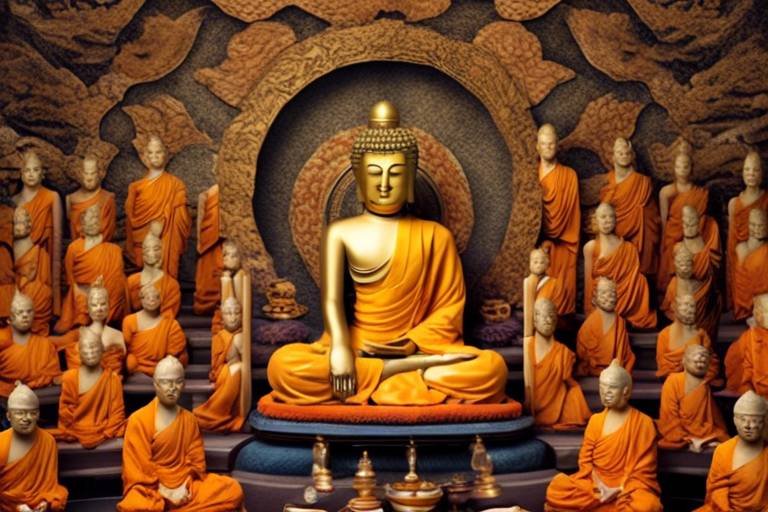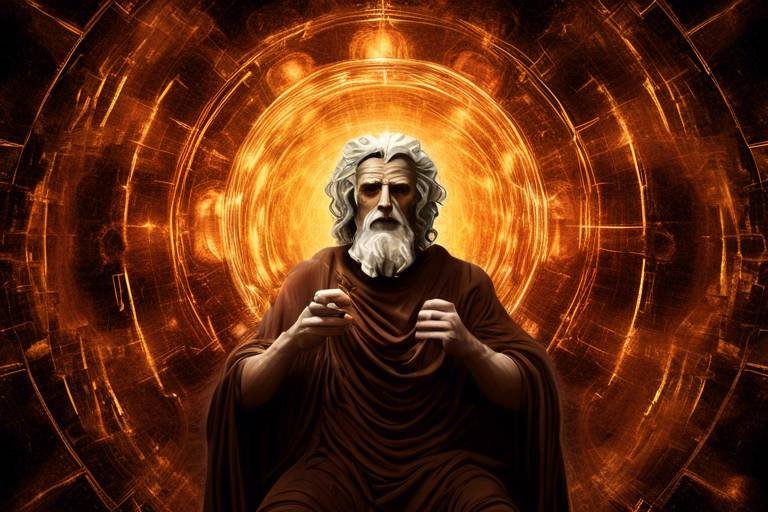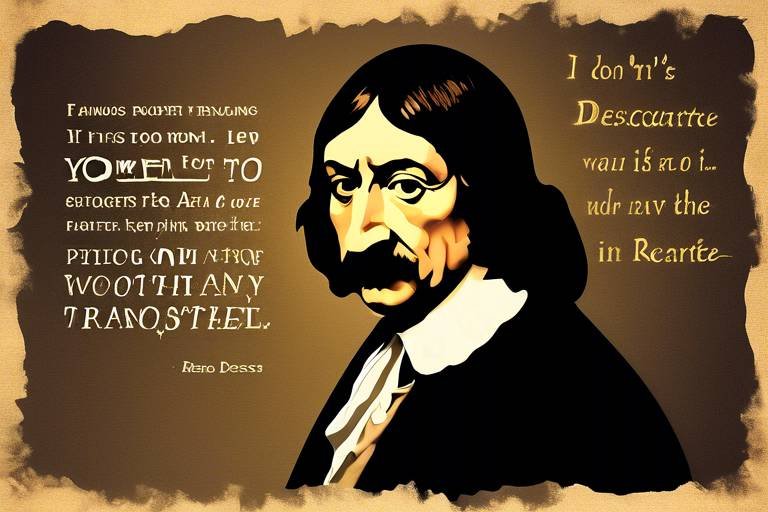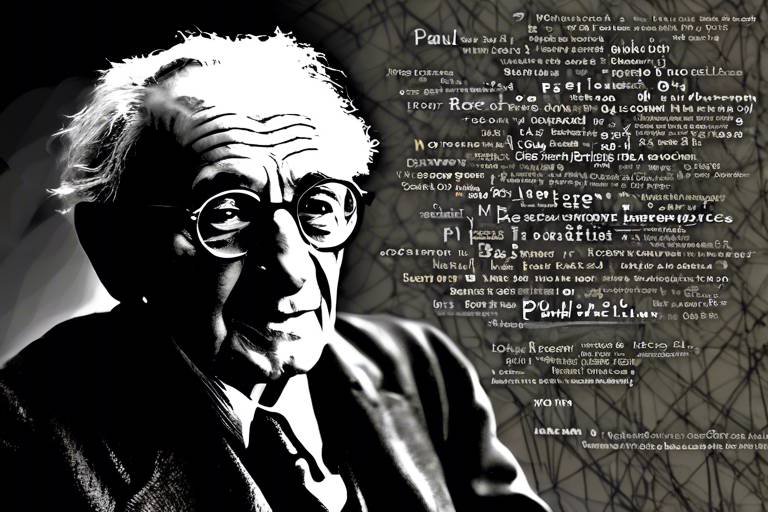Heraclitus—The Philosopher of Change and Unity
Heraclitus, often referred to as the "Weeping Philosopher," was a thinker who lived in ancient Greece around 500 BCE. His profound insights into the nature of existence resonate even today, making him a pivotal figure in the history of philosophy. One of his most famous assertions, "everything flows," encapsulates his belief that change is the only constant in life. This idea challenges us to reconsider our perceptions of stability and permanence. Imagine standing by a river; while the water may appear still, it is constantly moving, transforming, and renewing itself. Similarly, Heraclitus invites us to acknowledge that our lives, thoughts, and the universe itself are in a perpetual state of flux.
But Heraclitus didn’t just stop at the idea of change. He also proposed that opposites are not only necessary but also interconnected. His philosophy suggests that in order to understand unity, we must first embrace the contradictions that exist in the world. Think of day and night: they seem to be opposites, yet one cannot exist without the other. This interplay of opposites creates harmony and balance, a theme that runs through much of his work. By exploring these ideas, we begin to see that Heraclitus’ thoughts extend far beyond mere observations; they challenge us to rethink our relationship with the world around us.
As we dive deeper into Heraclitus' philosophy, we encounter the symbol of fire, which he used to represent transformation and the ever-changing nature of existence. Fire, in this context, is not just a physical element but a metaphor for the dynamic processes of life. It embodies both destruction and creation, illustrating how one state can lead to another. For instance, a forest fire may seem catastrophic, yet it often paves the way for new growth and rejuvenation. This duality is a powerful reminder that change can be both painful and beautiful, a theme that resonates through the ages.
Heraclitus' exploration of change and unity continues to influence various philosophical traditions, from the Stoics to modern existential thinkers. His insights offer a framework for understanding not only the cosmos but also our place within it. By recognizing the interconnectedness of all things and the inevitability of change, we can cultivate a deeper appreciation for the complexities of life. In a world that often seeks certainty, Heraclitus encourages us to embrace the unknown and find beauty in the transient nature of existence.
- What is the main idea of Heraclitus' philosophy? Heraclitus' philosophy centers on the concept of change, asserting that everything is in a constant state of flux and that opposites are interconnected.
- How does Heraclitus view the concept of unity? He believes that unity arises from the balance of opposites, where conflict and contradiction play a crucial role in creating harmony.
- What role does fire play in Heraclitus' thought? Fire symbolizes transformation and represents the dynamic processes of life, embodying both creation and destruction.
- How have Heraclitus' ideas influenced modern philosophy? His insights have shaped various philosophical traditions, particularly the Stoics, and continue to be relevant in contemporary discussions on change and identity.
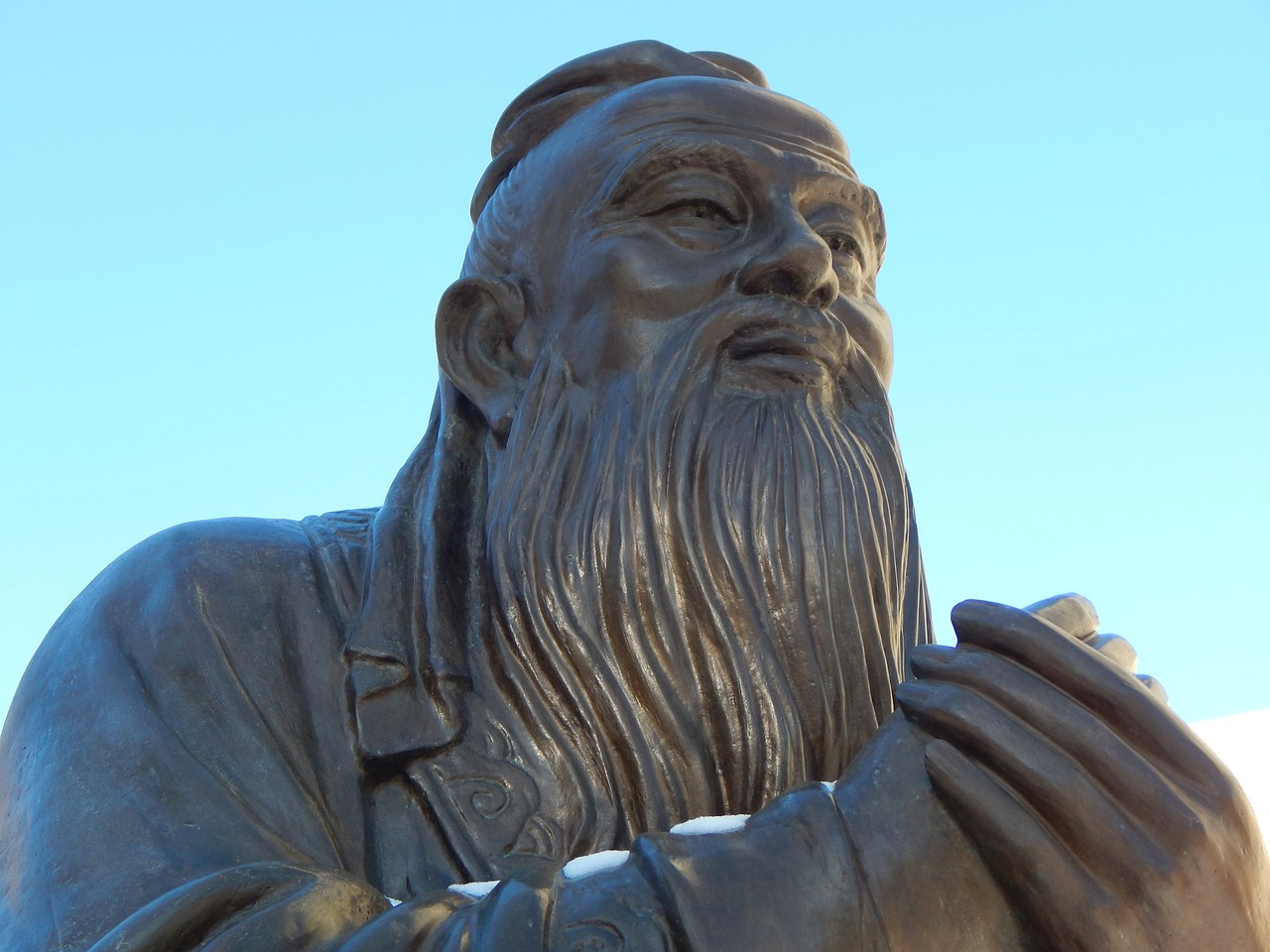
The Concept of Flux
Heraclitus is best known for his doctrine of constant change, famously asserting that everything flows. This idea, which may initially sound perplexing, invites us to reconsider our understanding of reality. Imagine standing by a river; the water that touches your feet is never the same as the water that flows past just moments later. In this way, Heraclitus teaches us that life is a continuous stream of change, where nothing remains static. This notion of flux extends beyond mere physical changes; it encapsulates the very essence of existence itself.
According to Heraclitus, the world is in a constant state of flux, meaning that everything around us is perpetually transforming. This perspective can be both liberating and daunting. On one hand, it encourages us to embrace change as an integral part of life, while on the other, it challenges our desire for stability and permanence. Think about it: how often do we find ourselves clinging to past experiences or yearning for a future that feels more secure? Heraclitus reminds us that such attachments can be illusory, as the only constant we can rely on is change.
To further illustrate this concept, consider the following ideas that Heraclitus proposed:
- Everything is in motion: From the smallest particles to the vast cosmos, everything is in a state of flux.
- Change is essential for growth: Just like a seed must break through the soil to grow into a tree, we too must embrace change to evolve.
- Stability is an illusion: What we perceive as stable is merely a momentary pause in the ongoing process of change.
Heraclitus' philosophy of flux challenges us to rethink how we engage with the world. Instead of resisting change, he encourages us to flow with it, adapting our thoughts and actions as circumstances evolve. This mindset can be transformative, allowing us to cultivate resilience and flexibility in our lives. In a world that often feels chaotic, embracing the concept of flux can empower us to navigate challenges with a sense of purpose and clarity.
Ultimately, Heraclitus' assertion that "everything flows" serves as a profound reminder that change is not just inevitable; it is the very foundation of existence. By accepting and understanding this principle, we can learn to appreciate the beauty of life's transient moments, fostering a deeper connection to ourselves and the world around us.

everything flows.
This article explores the profound ideas of Heraclitus, focusing on his views of change, unity, and the nature of existence, revealing how his philosophy continues to influence modern thought.
Heraclitus is best known for his doctrine of constant change, famously asserting that everything flows. This idea is not just a catchy phrase; it encapsulates a deep understanding of reality that resonates with our everyday experiences. Imagine standing by a river, watching the water cascade over rocks. Each moment, the water is different, yet it remains the river. Heraclitus believed that this principle of flux applies to all aspects of existence. Nothing remains static, and this constant state of change is fundamental to understanding our lives and the universe around us.
Heraclitus used the term "flux" to describe the ever-changing nature of the world. He famously stated, "You cannot step into the same river twice," highlighting the idea that both the river and the person stepping into it are in a state of constant transformation. This perspective invites us to reconsider our assumptions about stability and permanence. For instance, think about how our relationships evolve over time. Friends may drift apart, new connections form, and the dynamics of our interactions shift. Just like the flowing river, our lives are a tapestry woven from countless moments of change.
In practical terms, embracing the idea that everything flows can lead to a more adaptable mindset. When we recognize that change is inevitable, we can approach challenges with resilience. Instead of resisting the current, we can learn to navigate it, finding opportunities for growth and learning in the process. This mindset is crucial not only in personal development but also in professional settings, where the ability to adapt to new technologies and evolving markets can determine success.
Moreover, Heraclitus’ philosophy encourages us to appreciate the beauty of impermanence. Just as seasons change, bringing new colors and experiences, our lives are enriched by the variety that change brings. We can find joy in fleeting moments, understanding that their transience is what makes them precious. The next time you find yourself clinging to a moment or a feeling, remember that it is the very nature of life to flow and transform.
Heraclitus emphasized that opposites are interconnected and essential for harmony. This section examines how conflict and contradiction contribute to unity, illustrating his perspective on the balance of forces in the universe.
Fire symbolizes transformation and the ever-changing nature of existence in Heraclitus’ philosophy. This section discusses how fire represents both destruction and creation, embodying the dynamic process of becoming.
In Heraclitus' thought, fire serves as a powerful metaphor for change. This subsection explores how fire's qualities reflect the transient and transformative aspects of life, reinforcing his views on impermanence.
Heraclitus linked fire to the natural world, suggesting that it is a fundamental element of life. This subsection examines how fire's role in nature exemplifies the continuous cycle of birth, death, and rebirth.
The concept of Logos is central to Heraclitus’ philosophy, representing the underlying order of the cosmos. This section analyzes how Logos connects change and unity, providing a framework for understanding the universe.
Heraclitus’ ideas have significantly impacted various philosophical traditions. This section explores his influence on later thinkers, including the Stoics and modern existentialists, highlighting the enduring relevance of his insights.
The Stoics drew heavily from Heraclitus’ concepts, particularly the idea of Logos. This subsection discusses how Stoic philosophy adopted and adapted Heraclitus’ thoughts to develop their understanding of nature and ethics.
Contemporary philosophers continue to engage with Heraclitus’ ideas, particularly in discussions on change and identity. This subsection examines how modern thought interprets and applies his philosophy in various fields, including psychology and metaphysics.
- What does "everything flows" mean in Heraclitus' philosophy?
It signifies that all things are in a constant state of change and nothing remains the same. - How does Heraclitus' idea of change apply to modern life?
Understanding that change is inevitable can help us adapt and grow in various aspects of life. - What is the significance of fire in Heraclitus' teachings?
Fire symbolizes transformation, representing both destruction and creation, reflecting the dynamic nature of existence.

This section delves into his belief that nothing remains the same and how this concept shapes our understanding of reality.
This article explores the profound ideas of Heraclitus, focusing on his views of change, unity, and the nature of existence, revealing how his philosophy continues to influence modern thought.
Heraclitus is best known for his doctrine of constant change, famously asserting that everything flows. This section delves into his belief that nothing remains the same and how this concept shapes our understanding of reality.
Imagine standing by a river, watching the water rush past. You might think, “This water is always the same.” But is it? Just a moment later, the water you were looking at is gone, replaced by new water flowing in. This metaphor captures Heraclitus' idea of flux—his assertion that change is the only constant in life. Everything around us is in a state of perpetual motion, and even our thoughts and feelings are subject to this relentless tide of transformation. Heraclitus famously stated, “You cannot step into the same river twice,” highlighting that both the river and you are continuously evolving. This perspective challenges us to reconsider our understanding of reality, pushing us to embrace the dynamic nature of existence.
Heraclitus believed that our perception of stability is merely an illusion. In reality, the universe is a complex interplay of forces, constantly shifting and reshaping itself. He argued that the very essence of life is rooted in this unending change. To fully grasp his philosophy, we must accept that nothing is permanent, and that the only certainty we have is uncertainty itself. This realization can be both liberating and daunting. It encourages us to adapt, to grow, and to find meaning in the journey rather than in static endpoints.
Moreover, Heraclitus’ views on change extend beyond the physical world. They permeate our personal lives, relationships, and even our identities. As we navigate through life, we encounter numerous transitions—some joyful, some painful. Each experience shapes us, contributing to our evolving selves. Just like the river, we are not the same person we were yesterday; we are a culmination of our past experiences and present circumstances. This fluidity of identity can lead to profound insights about who we are and how we relate to the world around us.
In essence, Heraclitus challenges us to embrace change rather than resist it. By acknowledging that everything is in flux, we can cultivate a deeper appreciation for the moment, understanding that each experience is unique and fleeting. This philosophy invites us to live with intention, recognizing that our choices and actions are part of a larger, ever-changing tapestry of existence. In doing so, we can find harmony in the chaos and learn to navigate the complexities of life with grace.
Heraclitus emphasized that opposites are interconnected and essential for harmony. This section examines how conflict and contradiction contribute to unity, illustrating his perspective on the balance of forces in the universe.
Fire symbolizes transformation and the ever-changing nature of existence in Heraclitus’ philosophy. This section discusses how fire represents both destruction and creation, embodying the dynamic process of becoming.
In Heraclitus' thought, fire serves as a powerful metaphor for change. This subsection explores how fire's qualities reflect the transient and transformative aspects of life, reinforcing his views on impermanence.
Heraclitus linked fire to the natural world, suggesting that it is a fundamental element of life. This subsection examines how fire's role in nature exemplifies the continuous cycle of birth, death, and rebirth.
The concept of Logos is central to Heraclitus’ philosophy, representing the underlying order of the cosmos. This section analyzes how Logos connects change and unity, providing a framework for understanding the universe.
Heraclitus’ ideas have significantly impacted various philosophical traditions. This section explores his influence on later thinkers, including the Stoics and modern existentialists, highlighting the enduring relevance of his insights.
The Stoics drew heavily from Heraclitus’ concepts, particularly the idea of Logos. This subsection discusses how Stoic philosophy adopted and adapted Heraclitus’ thoughts to develop their understanding of nature and ethics.
Contemporary philosophers continue to engage with Heraclitus’ ideas, particularly in discussions on change and identity. This subsection examines how modern thought interprets and applies his philosophy in various fields, including psychology and metaphysics.
- What is the main idea of Heraclitus' philosophy?
Heraclitus is best known for his belief that everything is in constant change, encapsulated in the phrase "everything flows." He emphasizes that nothing remains the same. - How does Heraclitus view opposites?
Heraclitus believed that opposites are interconnected and essential for harmony, suggesting that conflict and contradiction contribute to unity in the universe. - What does fire symbolize in Heraclitus' philosophy?
Fire symbolizes transformation and the dynamic nature of existence, representing both destruction and creation as part of the continuous cycle of life. - How have Heraclitus' ideas influenced modern philosophy?
Heraclitus' concepts have significantly impacted various philosophical traditions, including Stoicism and modern existentialism, particularly in discussions about change and identity.
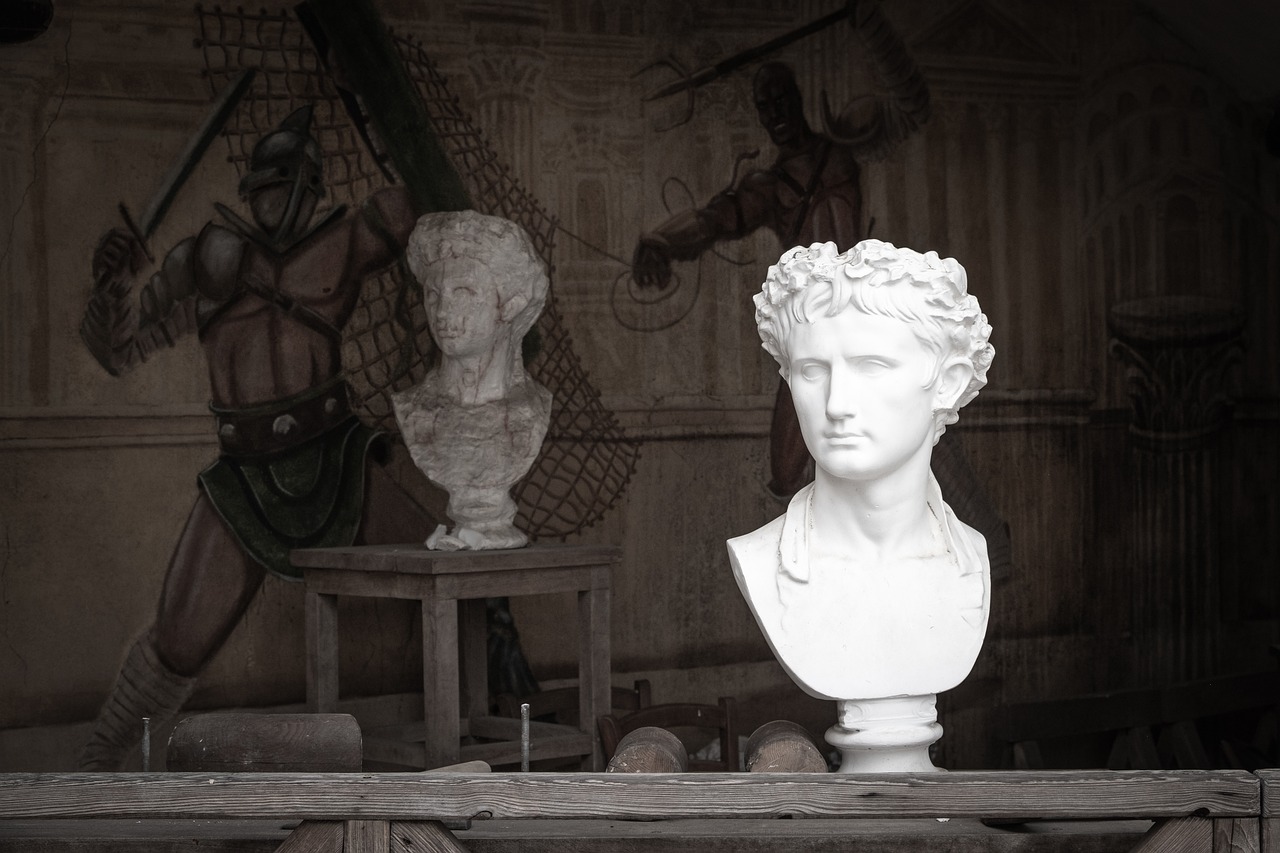
Unity of Opposites
Heraclitus, often regarded as the philosopher of change, took a unique approach to understanding the world around us. One of his most profound ideas is the concept of the . This notion suggests that seemingly contradictory forces are not only interconnected but also essential for harmony in the universe. Imagine a tightrope walker, balancing precariously between two opposing forces: gravity pulling them down and the tension in the rope holding them up. This delicate balance is akin to the unity of opposites that Heraclitus describes.
To grasp this concept, consider the dualities present in our daily lives. Light and dark, hot and cold, love and hate—these opposites coexist and define each other. Without darkness, how would we appreciate light? Without sadness, could we truly understand joy? Heraclitus believed that these contradictions are necessary for the existence of everything we experience. They create a dynamic tension that propels life forward, much like how the push and pull of the ocean tides shape the shoreline.
In Heraclitus' view, conflict and contradiction are not merely obstacles to overcome; they are vital components of the cosmic order. He famously stated, "War is the father of all things," suggesting that strife and struggle lead to creation and transformation. This perspective encourages us to embrace challenges rather than shy away from them. Just as a sculptor chisels away at a block of marble, revealing a magnificent statue hidden within, our struggles can carve out our true selves.
Furthermore, the unity of opposites is evident in nature. Think about the cycle of life: birth and death are two sides of the same coin. One cannot exist without the other. Heraclitus viewed this as a natural process, where each end is simply a new beginning. This cyclical nature of existence reinforces the idea that opposites are not in conflict but rather work together to create a harmonious whole. Just as seasons change, bringing both the warmth of summer and the chill of winter, life unfolds through a series of oppositional yet complementary phases.
To illustrate this concept further, consider the following table that highlights various pairs of opposites and their interdependence:
| Opposite Pair | Interdependence |
|---|---|
| Light & Dark | One defines the other; without darkness, light loses its meaning. |
| Hot & Cold | Temperature is perceived through contrast; extremes shape our understanding. |
| Love & Hate | Both are intense emotions that reveal the depth of human experience. |
| Life & Death | Life's value is often measured against the inevitability of death. |
In conclusion, Heraclitus’ notion of the unity of opposites invites us to view the world through a lens of interconnectedness. Instead of seeing conflict as a negative force, we can recognize it as a catalyst for growth and transformation. By embracing the dualities of life, we can attain a deeper understanding of our existence and the universe itself. So, the next time you encounter a challenge, remember that it may just be the flip side of a coin, leading you to greater harmony and balance.

The Role of Fire
In the grand tapestry of Heraclitus’ philosophy, fire emerges as a profound symbol of transformation and the ever-changing nature of existence. To him, fire was not just a physical element; it represented the very essence of change itself. Imagine for a moment the flickering flames of a fire—constantly moving, consuming, and creating anew. This imagery encapsulates Heraclitus’ belief that life is in a state of perpetual flux, where nothing remains static. Just as fire can illuminate a dark room, Heraclitus’ insights illuminate our understanding of reality, urging us to embrace change rather than fear it.
Heraclitus believed that fire embodies both destruction and creation, merging these seemingly opposing forces into a dynamic process of becoming. This duality is crucial to understanding his philosophy. The flames that consume wood also provide warmth and light, illustrating how endings can lead to new beginnings. In this sense, fire serves as a powerful reminder that life’s transitions, while sometimes painful, are essential for growth and renewal. It’s like the seasons; winter may seem bleak, but it paves the way for the vibrant blooms of spring.
Moreover, fire is not just a metaphor in Heraclitus’ thought; it is intricately linked to the natural world. He posited that fire is a fundamental element of life, playing a vital role in the continuous cycle of birth, death, and rebirth. Just as stars are born from cosmic fires, so too do we experience cycles of transformation in our own lives. The following table illustrates the relationship between fire and the cycles of nature:
| Cycle | Fire's Role |
|---|---|
| Birth | Fire ignites new beginnings, symbolizing potential and growth. |
| Death | Fire consumes, representing endings and the clearing away of the old. |
| Rebirth | Fire transforms, leading to renewal and new life. |
Ultimately, Heraclitus’ perspective on fire encourages us to recognize the beauty in change. It’s a call to embrace the flames of our own experiences, understanding that they shape who we are. Just as fire can forge metal into tools, our challenges and transformations can mold us into stronger individuals. So, the next time you feel overwhelmed by change, remember the role of fire; it’s not just about destruction, but about the endless possibilities that arise from the ashes.
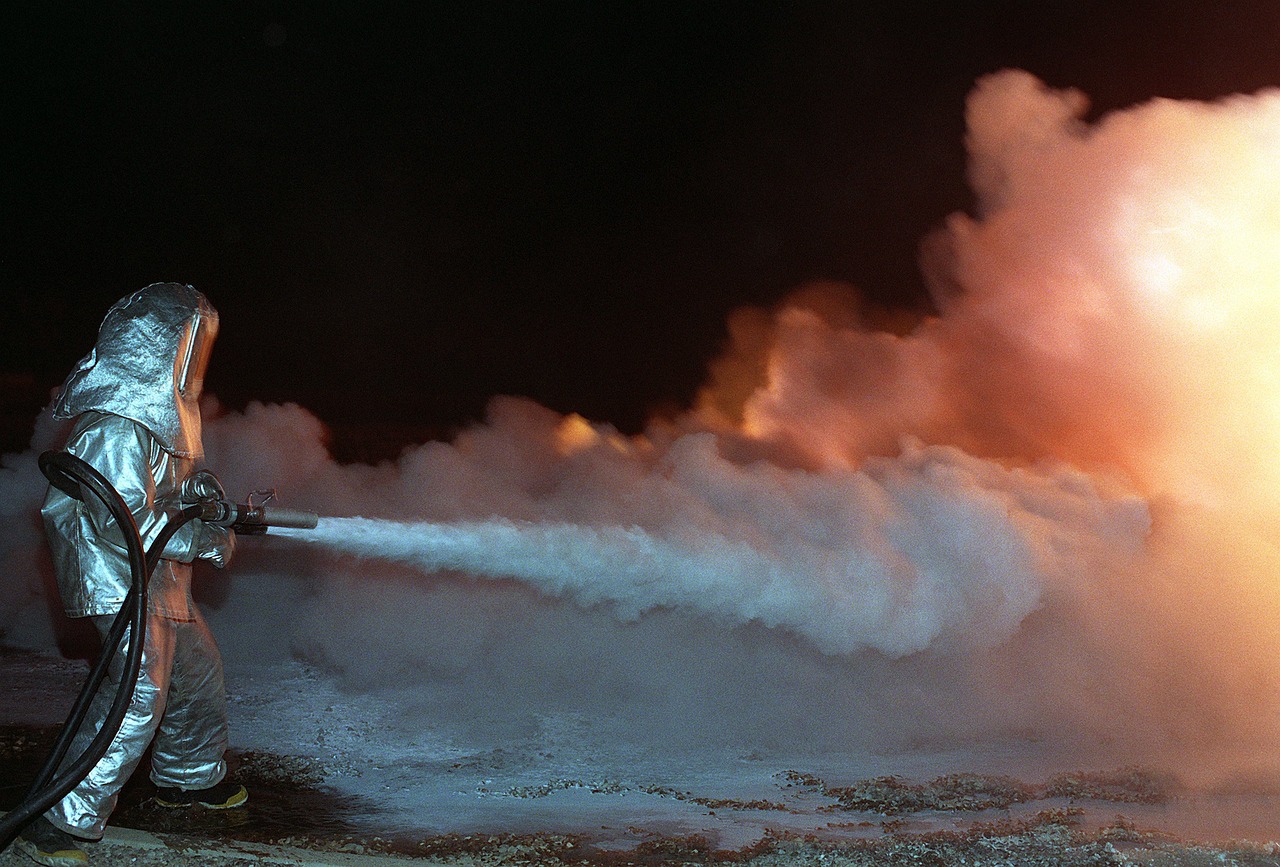
Fire as a Metaphor
In the realm of philosophy, few symbols resonate as powerfully as fire in Heraclitus' thought. Fire is not merely a physical element; it embodies the very essence of change and transformation. Just as a flame flickers and dances, altering its shape and intensity with every breath of wind, so too does life shift and evolve. Heraclitus famously stated, "You cannot step into the same river twice," highlighting that every moment is fleeting, much like the flames that consume and reshape their surroundings.
Moreover, fire serves as a profound metaphor for the dualities of existence. It is both destructive and creative, a force that can reduce to ashes or spark new beginnings. This duality mirrors the human experience—our lives are often marked by moments of loss that pave the way for new opportunities. In this light, fire represents the transitory nature of our experiences, reminding us that endings are often the precursors to fresh starts.
Consider the way fire interacts with its environment. It requires fuel to burn, just as our passions and desires fuel our actions. Without the right conditions, fire can extinguish, symbolizing how our potential can fade without nurturing. This dynamic relationship illustrates Heraclitus' core belief that everything is interconnected, and that change is the only constant. The flickering flame is a reminder that to embrace life fully, we must accept both its light and its shadows.
In essence, fire encapsulates the idea that life is a series of transformations, each as vital as the last. It urges us to reflect on our own journeys—how we can harness our inner flames to ignite change, foster growth, and embrace the inevitable cycles of life. Just as fire can warm a home or forge a weapon, so too can our experiences shape us into who we are meant to be.

Fire in Nature
In the grand tapestry of nature, fire holds a unique and vital role, symbolizing the perpetual cycle of birth, death, and rebirth. Heraclitus viewed fire not just as a physical phenomenon but as a fundamental element of existence itself. Imagine a wildfire sweeping through a forest; while it may seem destructive, it also paves the way for new growth. This duality captures the essence of Heraclitus' philosophy, where fire embodies both the end and the beginning of life. Just as a phoenix rises from its ashes, nature continuously transforms through the interplay of destruction and creation.
Fire is a catalyst in various natural processes, influencing ecosystems in ways that are often overlooked. For instance, many plant species rely on fire for their propagation. Certain seeds only germinate after being exposed to extreme heat, showcasing how fire can trigger new life. The ecological benefits of fire include:
- Clearing Dead Material: Fire removes old, dead vegetation, allowing sunlight to reach the soil.
- Encouraging Biodiversity: It creates a mosaic of habitats, fostering diverse plant and animal communities.
- Regulating Insect Populations: Fires can help control pests and diseases that threaten plant life.
Moreover, Heraclitus believed that fire's transformative nature mirrors the changes inherent in life itself. Just like fire consumes and transforms matter, our experiences shape us. Every challenge we face can be seen as a fire that tests our resilience and ignites our potential. This metaphor extends beyond the physical realm, suggesting that change—like fire—is an essential and inevitable part of our existence.
Furthermore, the cycle of fire in nature is a powerful reminder of the interconnectedness of all things. When a fire occurs, it affects not just the immediate area but also the broader ecosystem. Animals may flee, plants may regenerate, and soil may become enriched with nutrients released from burnt material. This interconnectedness resonates with Heraclitus' idea that opposites are essential for harmony. In nature, destruction leads to creation, and chaos eventually gives way to order.
In summary, fire in nature serves as a profound metaphor for the dynamic processes of life. It illustrates how destruction can lead to new beginnings and highlights the interconnectedness of all living things. By understanding fire's role in the natural world, we gain insight into Heraclitus' philosophy and the perpetual dance of change that defines our existence.
1. Why is fire important in ecosystems?
Fire plays a crucial role in maintaining healthy ecosystems by clearing out dead vegetation, promoting new growth, and fostering biodiversity.
2. How does Heraclitus view change?
Heraclitus believed that change is the only constant in life, famously stating that "everything flows." He saw change as a fundamental aspect of existence.
3. What does fire symbolize in Heraclitus' philosophy?
In Heraclitus' thought, fire symbolizes transformation and the cyclical nature of existence, embodying both destruction and creation.
4. Can fire have positive effects on the environment?
Yes, fire can have beneficial effects, such as promoting new plant growth and regulating insect populations, which are essential for a balanced ecosystem.

Logos: The Rational Principle
In the heart of Heraclitus’ philosophy lies the concept of Logos, a term that resonates with profound significance. Often translated as "word," "reason," or "principle," Logos embodies the underlying order and structure of the universe. Imagine Logos as the blueprint of existence, a guiding force that shapes the chaotic flux of life. Heraclitus believed that while everything is in a state of constant change, there is an inherent logic that governs this transformation. This duality of chaos and order is what makes his philosophy so compelling.
To understand Logos, one must first grasp how it reconciles the seemingly contradictory elements of existence. Heraclitus famously stated, "The road up and the road down are the same thing." This statement illustrates the interconnectedness of opposites, suggesting that conflict and harmony are two sides of the same coin. In the grand tapestry of the cosmos, Logos serves as the thread that weaves these opposites together, creating a cohesive narrative out of the apparent chaos. It's like a symphony where each instrument plays a different note, yet together they create a beautiful harmony.
Furthermore, Logos is not just an abstract concept; it has practical implications for how we perceive reality. It encourages us to look beyond the surface and recognize the patterns that govern our lives. For instance, consider the cycles of nature: the changing seasons, the ebb and flow of tides, and the life-death-rebirth cycle. All these phenomena exemplify the principle of Logos at work, demonstrating that change is not random but rather follows a rational order. This perspective invites us to embrace change as a natural part of life, rather than something to be feared.
In addition, the influence of Logos extends to various fields of thought. Many philosophers have drawn upon Heraclitus' insights, recognizing that understanding the rational principle can lead to a deeper comprehension of both the universe and ourselves. For example, in modern psychology, the idea of cognitive frameworks mirrors the concept of Logos, where our perceptions shape our reality. By aligning our thoughts with the rational principles of the universe, we can navigate the complexities of life with greater clarity.
Ultimately, Heraclitus’ notion of Logos serves as a reminder that while change is the only constant, there exists a rational framework that underpins this flux. It challenges us to seek understanding in the chaos, to find unity in diversity, and to acknowledge that every ending is but a new beginning. As we engage with the world around us, embracing the principles of Logos can empower us to lead more meaningful lives, grounded in the wisdom of change.

The Influence of Heraclitus
Heraclitus, often referred to as the "Weeping Philosopher," has left an indelible mark on the landscape of philosophy, inspiring generations of thinkers with his profound insights into change and unity. His ideas, particularly the concept of flux and the unity of opposites, resonate deeply across various philosophical traditions. The ripples of his thoughts can be seen in the works of later philosophers, especially the Stoics, who embraced his notions of Logos and the eternal nature of transformation. But how exactly did Heraclitus influence these later thinkers, and why does his philosophy hold such enduring relevance today?
To understand the influence of Heraclitus, we must first recognize the core tenets of his philosophy. He posited that the universe is in a constant state of flux, famously declaring that "you cannot step into the same river twice." This notion of perpetual change laid the groundwork for various philosophical inquiries into the nature of existence and identity. The Stoics, for instance, adopted his ideas to form a robust framework for understanding ethics and the natural world. They viewed the rational principle of Logos, which Heraclitus articulated, as a guiding force that governs both the cosmos and human behavior.
Moreover, Heraclitus’ influence extends beyond ancient philosophy into modern thought. Contemporary philosophers grapple with his ideas in fields such as psychology, metaphysics, and existentialism. The questions he raised about identity and change continue to challenge our understanding of the self in a world that is perpetually shifting. For instance, modern existentialists often echo Heraclitus' sentiment that our identities are not fixed but are instead shaped by our experiences and the ever-changing circumstances of life.
His thoughts have sparked discussions that bridge the gap between ancient wisdom and contemporary issues. In fact, many modern thinkers have sought to reinterpret Heraclitus’ philosophy in light of current scientific discoveries, particularly in areas like quantum physics and chaos theory, which also emphasize the dynamic and interconnected nature of reality.
To illustrate the breadth of Heraclitus' influence, consider the following table that highlights key philosophers and their connections to Heraclitus' ideas:
| Philosopher | Connection to Heraclitus |
|---|---|
| Stoics | Adopted the concept of Logos; emphasized rational order in a changing universe. |
| Hegel | Explored the dialectical process of change and development, echoing the unity of opposites. |
| Nietzsche | Embraced the idea of eternal recurrence, reflecting on the cyclical nature of existence. |
| Existentialists | Investigated themes of identity and change, building on Heraclitus' notions of flux. |
In summary, the influence of Heraclitus is profound and multifaceted. His philosophy not only shaped ancient thought but also continues to inspire modern philosophical discourse. As we navigate our own lives, filled with constant change, Heraclitus’ insights remind us that embracing the flux of existence can lead to a deeper understanding of ourselves and the world around us.
- What is the main idea of Heraclitus' philosophy? Heraclitus is best known for his doctrine of constant change, encapsulated in the idea that "everything flows." He believed that nothing remains the same and that change is the fundamental essence of existence.
- How did Heraclitus influence the Stoics? The Stoics adopted Heraclitus' concept of Logos, viewing it as the rational principle that governs the universe. They integrated his ideas into their understanding of ethics and nature.
- Why is Heraclitus relevant today? Heraclitus' insights into change and identity resonate in modern discussions about the self and reality, influencing fields such as psychology and existentialism.

Heraclitus and the Stoics
Heraclitus’ philosophy left an indelible mark on the development of Stoic thought, as the Stoics found profound resonance in his ideas about change and the nature of reality. The Stoics, a school of thought that emerged in ancient Greece, were particularly captivated by Heraclitus’ concept of Logos, which represents the rational principle that orders the cosmos. They interpreted this idea as a guiding force that not only governs the universe but also offers a framework for human behavior and ethics.
One of the key ways the Stoics integrated Heraclitus’ ideas was through their understanding of the nature of change. For Heraclitus, everything is in a state of flux; nothing remains static. This notion echoed strongly within Stoic philosophy, which teaches that individuals must accept the impermanence of life. Just as Heraclitus famously stated, "You cannot step into the same river twice," the Stoics emphasized that life is a continuous flow of experiences and challenges. They believed that by embracing this fluidity, one could cultivate a sense of inner peace and resilience.
The Stoics also adopted Heraclitus’ perspective on opposites, recognizing that conflict and contradiction are essential for harmony. They argued that understanding the interplay between different forces is crucial for achieving balance in life. For instance, the Stoics viewed emotions such as anger and joy not as isolated experiences but as parts of a larger whole, much like Heraclitus’ idea that strife is necessary for the creation of unity. This interconnectedness between opposites is a cornerstone of Stoic ethics, guiding individuals to navigate the complexities of existence with wisdom and grace.
Moreover, the Stoics took Heraclitus’ metaphor of fire and applied it to their own understanding of transformation. They saw fire not only as a destructive force but also as a catalyst for growth and renewal. In this way, the Stoics echoed Heraclitus’ belief that out of chaos emerges order, and from destruction comes creation. This duality is reflected in the Stoic practice of amor fati, or love of fate, encouraging individuals to embrace their circumstances, however challenging, as opportunities for personal development.
In summary, the influence of Heraclitus on the Stoics is profound and multifaceted. By adopting and adapting his ideas on change, unity, and the rational order of the cosmos, the Stoics were able to construct a robust philosophical framework that resonates even today. Their teachings encourage us to reflect on the transient nature of life, embrace the challenges we face, and find harmony within the chaos. This dialogue between Heraclitus and the Stoics not only enriches our understanding of ancient philosophy but also provides timeless insights into the human experience.
- What is the main idea behind Heraclitus' philosophy?
Heraclitus is best known for his doctrine of change, famously stating that "everything flows," emphasizing that nothing remains the same and that change is a fundamental aspect of existence. - How did the Stoics interpret Heraclitus' concept of Logos?
The Stoics viewed Logos as the rational principle that orders the cosmos, which they believed was essential for understanding nature and guiding ethical behavior. - What role do opposites play in Stoic philosophy?
Stoics believed that opposites are interconnected and necessary for harmony, reflecting Heraclitus' idea that conflict and contradiction contribute to unity. - How does Heraclitus’ idea of fire relate to Stoicism?
Fire symbolizes transformation in Heraclitus’ philosophy, and the Stoics adopted this metaphor to illustrate the process of change, renewal, and the acceptance of life's challenges.

Modern Interpretations
In today's fast-paced world, the ideas of Heraclitus resonate more than ever. His assertion that "everything flows" isn't just a philosophical musing; it mirrors the reality we experience daily. From the rapid advancements in technology to the shifting landscapes of societal norms, change is the only constant. Modern thinkers have taken Heraclitus' insights and woven them into various fields, creating a rich tapestry of interpretations that help us navigate our ever-evolving lives.
Philosophers, psychologists, and even artists have found inspiration in Heraclitus' notions of change and unity. For instance, in psychology, the idea that our identities are not fixed but rather fluid aligns closely with Heraclitus' philosophy. This has led to a greater understanding of personal growth and transformation, emphasizing that our past does not dictate our future. Just like a river, we are continuously shaped by our experiences, flowing and adapting along the way.
Moreover, in the realm of existentialism, thinkers like Jean-Paul Sartre and Martin Heidegger have echoed Heraclitus' sentiments about existence and the human condition. They explore the tension between permanence and change, urging individuals to embrace the uncertainty of life. This perspective encourages a deeper engagement with our choices and the understanding that we are not merely observers but active participants in our own becoming.
Interestingly, Heraclitus' ideas have also permeated the world of art and literature. Many contemporary artists draw on the themes of transformation and impermanence, creating works that reflect the transient nature of existence. For example, installations that change over time or performances that evolve with each showing encapsulate Heraclitus' philosophy, inviting audiences to witness the beauty of change rather than resist it.
As we delve deeper into modern interpretations of Heraclitus, we see that his concepts are not just academic; they are practical tools for understanding our lives. They encourage us to embrace change, recognize the unity in opposites, and understand that through chaos, we can find order. This holistic approach to life has become increasingly relevant in a world that often feels overwhelming and unpredictable.
To further illustrate the impact of Heraclitus' ideas in modern thought, consider the table below, which highlights key areas of influence:
| Field | Key Concepts | Influential Thinkers |
|---|---|---|
| Psychology | Fluid identity, personal growth | Carl Rogers, Abraham Maslow |
| Philosophy | Existentialism, choice and existence | Jean-Paul Sartre, Martin Heidegger |
| Art | Transformation, impermanence | Yoko Ono, Olafur Eliasson |
In conclusion, Heraclitus' philosophy continues to inspire and challenge us to rethink our understanding of change and existence. By exploring these modern interpretations, we not only honor his legacy but also equip ourselves with the wisdom to navigate the complexities of contemporary life.
- What is the main idea of Heraclitus' philosophy?
Heraclitus is primarily known for his doctrine of change, emphasizing that everything is in a state of flux and that opposites are interconnected. - How does Heraclitus influence modern psychology?
His ideas about fluid identity and personal growth resonate with contemporary psychological theories that focus on transformation and adaptability. - What role does fire play in Heraclitus' philosophy?
Fire symbolizes transformation and the dynamic nature of existence, representing both destruction and creation in the cycle of life. - How do modern artists interpret Heraclitus' concepts?
Many contemporary artists incorporate themes of change and impermanence into their work, reflecting the transient nature of existence.
Frequently Asked Questions
- What is the main idea behind Heraclitus' philosophy?
Heraclitus is best known for his doctrine of change, famously stating that "everything flows." He believed that nothing remains static and that change is the fundamental essence of existence. This idea encourages us to embrace the fluid nature of life and recognize that all things are in a constant state of becoming.
- How does Heraclitus explain the concept of unity in opposites?
Heraclitus emphasized that opposites are not just conflicting forces but are interconnected and essential for harmony. He argued that conflict and contradiction can lead to unity, illustrating that balance is achieved through the interplay of opposing elements. This perspective invites us to see the value in differences and how they contribute to a greater whole.
- What role does fire play in Heraclitus' philosophy?
Fire is a central symbol in Heraclitus' thought, representing transformation and the dynamic nature of existence. It embodies both destruction and creation, illustrating the continuous cycle of change. Fire serves as a metaphor for life itself, highlighting the transient and transformative aspects that define our experiences.
- What is the significance of Logos in Heraclitus' ideas?
Logos represents the rational principle that underlies the cosmos in Heraclitus’ philosophy. It connects the concepts of change and unity, offering a framework for understanding the order of the universe. Through Logos, we can grasp how seemingly chaotic changes contribute to a coherent and structured reality.
- How did Heraclitus influence later philosophical traditions?
Heraclitus had a profound impact on various philosophical schools, particularly the Stoics, who incorporated his ideas about Logos into their own understanding of nature and ethics. His thoughts on change and identity continue to resonate in modern existentialist discussions, illustrating the lasting relevance of his insights across time.
- What modern interpretations exist of Heraclitus' philosophy?
Contemporary philosophers often engage with Heraclitus’ concepts, particularly in fields like psychology and metaphysics. His ideas about change and identity are explored in various contexts, offering fresh perspectives on how we understand ourselves and the world around us. This ongoing dialogue ensures that Heraclitus remains a significant figure in philosophical discourse today.



